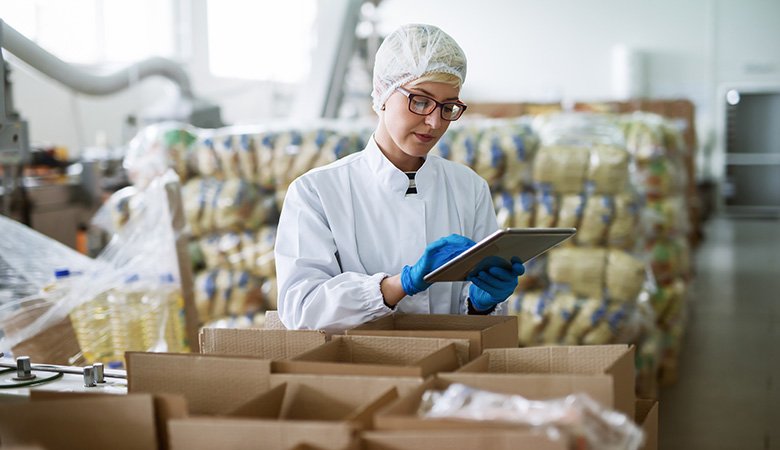Lavagem Industrial / Artigos
3 trends for the food sector in 2023
Innovation, sustainability, efficiency. These are the most relevant trends for 2023 in the food sector.

 8 minutos de leitura
8 minutos de leitura
2022-12-09 17:15:40
Innovation, sustainability, efficiency. These are the most relevant trends for 2023 in the food sector.
With the new year ahead, it is time to reflect on the major trends that will shape the food sector in 2023. From the much-heralded end of plastic to new technologies that let equipment talk to each other, these are the 3 major trends that will affect every company – and what you can do to get ahead of them.
1. The Internet of Things and 5G will transform what we know about food
The explosive combination of the Internet of Things (IoT) and 5G will continue to shape the food industry in 2023. The two technologies allow equipment in the production and logistics chains to “talk” to each other, exchanging information vital to efficiency and safety. All sectors will be affected, and the food area more than most. For instance, if a problem emerges somewhere in the supply chain, IoT can adjust the remaining downstream processes accordingly. If a supplier misses a delivery, these technologies can adjust production to minimize setup times to ensure your customers will not be impacted. All this without human intervention to save time and increase productivity.
The potential for transparency and food tracking is enormous. IoT and 5G can help businesses and consumers track products throughout the value chain, ensuring that critical information is always accessible, “farm-to-table”, from harvest to consumption. With the help of IoT, it is possible to know if suppliers maintained safe levels of carbon dioxide, heavy metals, humidity, temperature, or even safe shipping times and storage conditions. If sensors detect values outside the tolerance parameters, they may even automatically alert authorities and consumers.
In addition, IoT can predict maintenance needs, avoiding unexpected stops or interruptions. It ensures that maintenance is performed proactively, rather than being focused on reactive repairs, resulting in greater overall equipment efficiency (OEE).
2. Reducing water and energy consumption will remain a priority in 2023
The figures are disturbing: The Food and Agriculture Organization estimates that the food industry consumes 30% of the world’s energy and accounts for 20% of greenhouse gas emissions. In addition, it accounts for 19% of water consumption worldwide, with an increase of around 20 to 30% expected by 2050.
For these reasons, the focus on reducing water and energy is and will continue to be a strong trend for years to come, especially regarding electricity, water, or food – after all, about a third of the food produced ends up discarded. Only through continuous improvement, updated equipment and highly trained staff can companies tackle such issues.
Everyone can contribute. Operators can report leaks, keep the space around the machines clean and dry, and learn to solve simple problems. Maintenance teams can maintain the correct state of the equipment in order to prolong its longevity and ensure energy and water efficiency. Purchasing teams have a choice to pick local suppliers, organic ingredients and partners with sustainable farming practices. In this way, companies support local development, reduce transport-related emissions, ensure fresher ingredients with less use of energy in conservation and still get greater control over their suppliers’ practices.
Washing utensils and tools is one process that requires more water and energy in food companies. Because of the intensive use of these resources, this is a natural area for optimization, where top equipment delivers significant savings. A good example of this type of equipment is the Multiwasher, an industrial washing equipment whose unprecedented efficiency saves about 2/3 of water compared to other industrial washing solutions.
3. Sustainability as a top priority
It is impossible to talk about 2023 and not mention sustainability. Waste management, in particular, is poised to be one of the major focuses of the coming year, and refers to the set of actions to avoid, reduce, reuse or dispose of waste arising from industrial activity. It was precisely this concern that led brands like Samsung to produce top-of-the-range smartphones from plastics removed from the oceans. It also led brands such as Ikea or Nike to create buy-back schemes, allowing consumers to “sell” back to the company the products they no longer use. Such innovative solutions will continue to grow next year.
Another of the major sustainability priorities is plastic reduction, an area in which the food sector still has a long way to go: Nestlé, Coca-Cola and PepsiCo, have been the world’s largest plastic polluters for three consecutive years now. That fact is in sharp contrast with multiple announcements in the right direction. Nestlé has already committed to making 100% of its packaging recycled or recyclable by 2025. Coca Cola did the same year, but until 2030.
However, the advance towards a world without plastic has not been without setbacks. After announcing that it would return to glass bottles, Coca Cola reversed the decision and kept the packaging “because it was more popular with consumers”. When Starbucks finally introduced recycled straws, they turned out to have more plastic than the non-recycle alternative, a consequence of the inability to filter out plastic in recycling.
The path to sustainability is not easy in any sector, let alone in the food industry, where chronic dependence on plastics, long and complex logistics chains, and a high diversity of waste makes transitioning even more of a challenge. Strategies inevitably involve prevention, reduction, reuse, recycling, recovery, and correct elimination. And, of course, adopting one of several alternatives to disposable plastics available to companies of all sizes.
Next year promises new challenges for food companies. Soaring inflation and the instability of war, a cost-of-living crisis, the remnants of a pandemic, consumers’ concerns about exactly what they are ingesting are some factors that will increase the pressure to change. Throughout the year, these three trends, which are not exactly new, will be even more pronounced. To get ahead, business should adopt a renewed focus on continuous improvement and choose partners and technologies that can support them on this path. In the food sector and in particular in industrial washing, MultiWasheris helping the most innovative companies navigate these changes. It is a state-of-the-equipment that can wash all kinds of utensils – parts, tools, transport carts, trays, dishes – with a minimum consumption of water, energy and detergent. Schedule a webinar, without compromise, to see the difference.
Também pode gostar

Lavagem Industrial / ArtigosArtigos
“We achieved every goal we set last year “
New markets, partners and innovations. Tony Ventura, CEO of Somengil, recaps last year and sets his sights on the future – of Somengil and the wa...
Postado em 2022-02-24

Lavagem Industrial / ArtigosArtigos
Pharmaceutical industry: how to choose the right industrial washing solution
In the pharmaceutical industry, industrial washing is a critical success factor. Find out how to choose the right equipment.
Postado em 2024-03-08

Lavagem Industrial / ArtigosArtigos
Circular economy: nothing is lost, everything is transformed
Circular economy is a new way of thinking about the future and the relationship with the planet. Find out what it means and how you can transitio...
Postado em 2022-10-20






















 Português
Português English (UK)
English (UK) English (USA)
English (USA) Français
Français Español
Español Deutsch
Deutsch